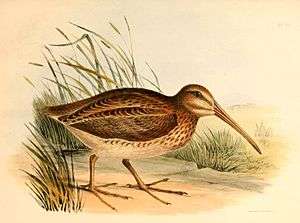Subantarctic snipe
| Subantarctic snipe | |
|---|---|
 | |
| Scientific classification | |
| Kingdom: | Animalia |
| Phylum: | Chordata |
| Class: | Aves |
| Order: | Charadriiformes |
| Suborder: | Scolopaci |
| Family: | Scolopacidae |
| Genus: | Coenocorypha |
| Species: | C. aucklandica |
| Binomial name | |
| Coenocorypha aucklandica (Gray, 1845) | |
The Subantarctic snipe (Coenocorypha aucklandica) is a species of snipe endemic to New Zealand's subantarctic islands. The Maori call it "Tutukiwi". The nominate race C. a. aucklandica (Auckland snipe) is found on the Auckland Islands (excluding the main island). Other subspecies include C. a. meinertzhagenae (Antipodes snipe) from the Antipodes Islands, and C. a. perseverance (Campbell snipe) from Campbell Island. The former subspecies from the Snares Islands has been separated as a full species, the Snares snipe (C. huegeli), as have the extinct South Island (C. iredalei) and North Island snipes (C. barrierensis).
Description
The Subantarctic snipe is a small wading bird with adults growing to about 23 cm (9 in) in length. It has cryptic brown plumage, sturdy legs and a slender beak about 5 cm (2 in) long. The head is striped in black and reddish brown and the body is brown, mottled with black and reddish brown.[2]
Distribution
The Subantarctic snipe is endemic to certain islands to the south of New Zealand. Each island or group of islands has its own subspecies. The Stewart Island snipe (C. a. iredalei) became extinct on Jacky Lee Island when the flightless weka was introduced and on Big South Cape Island after brown rats (Rattus rattus) arrived there in 1964. The last Little Barrier Snipe (C. a. barrierensis) was seen in 1870. The Campbell Island Snipe (C. a. perseverance) were nearly extinguished but a few remained on an outlying islet and recolonised the main island when rats were exterminated there. A further three subspecies are (C. a. huegeli) on the Snares Islands, (C. a. meinertzhagenae) on the Antipodes Islands and (C. a. aucklandica) on the Auckland Islands.[3]
Behaviour
The Subantarctic snipe seldom flies, is relatively tame and nests on the ground and this puts it at risk of predation by land-based predators. It favours areas of dense ground cover and feeds on a range of invertebrates. It has a characteristic courtship display which takes place at night when males make vertical dives from considerable heights. Nesting takes place at different dates between August and January on the different islands.[2][3]
References
- ↑ BirdLife International (2012). "Coenocorypha aucklandica". IUCN Red List of Threatened Species. Version 2013.2. International Union for Conservation of Nature. Retrieved 26 November 2013.
- 1 2 "Species factsheet: Coenocorypha aucklandica". BirdLife International. Retrieved 2013-12-16.
- 1 2 Oliver, Narina (2010-10-09). "Hakawai, the New Zealand snipe". New Zealand Birds. Retrieved 2013-12-16.
- Miskelly, Colin M. (1987): The identity of the hakawai. Notornis 34(2): 95-116. PDF fulltext
- Miskelly, Colin M.; Bell, Elizabeth A.; Elliott, Graeme P. & Walker, Kath J. (2006): 'Hakawai' aerial displaying by three populations of subantarctic snipe (genus Coenocorypha). Notornis 53(4): 375-381. HTML abstract
| Wikimedia Commons has media related to Subantarctic snipe. |
| Wikispecies has information related to: Coenocorypha aucklandica |
